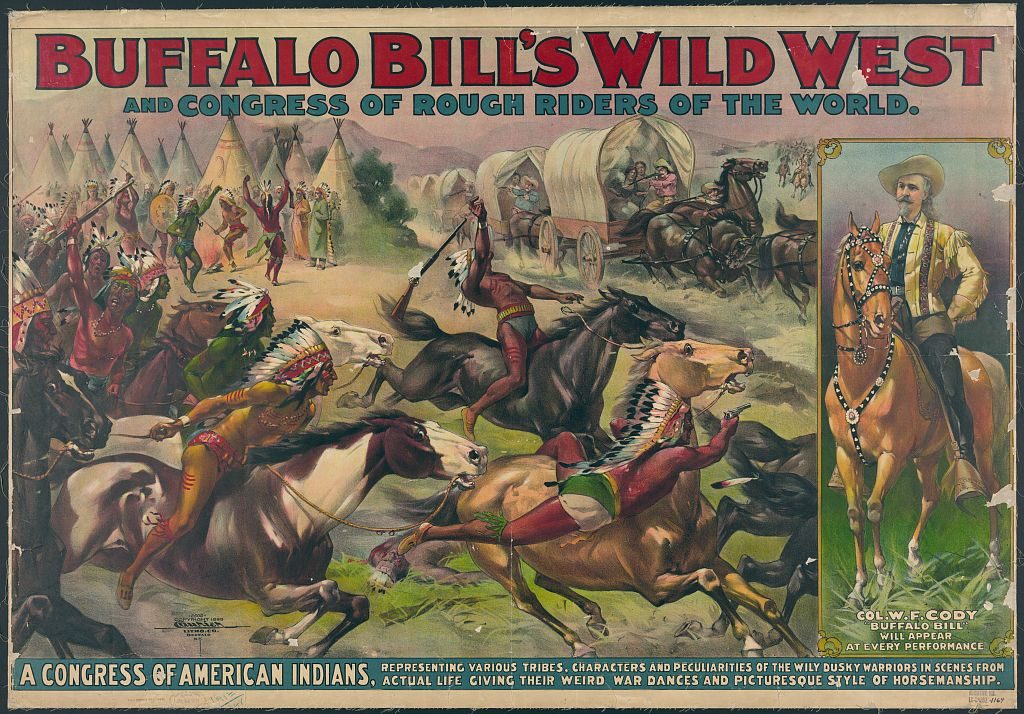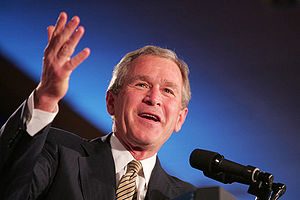In 1883, William “Buffalo Bill” Cody, famous frontiersman, army scout, and buffalo hunter, opened the doors of his Wild West Show for the first time.1 This show was a fantastical, exaggerated portrayal of life on the frontier, complete with reenactments of famous frontier battles with natives, displays by gifted marksmen (and one woman) and horsemen, and shows of the culture of the various Native Americans in Bill’s employ. This show would capture the hearts and minds of many people in the United States, and later on even in Europe, as Buffalo Bill’s show traveled to many European countries between 1886 and 1906.2

One of the reasons for the success of Buffalo Bill’s show was its “authenticity.” Bill himself was already somewhat of a celebrity in the west, after having earned his moniker “Buffalo Bill” for killing some 4,280 buffalo for the Kansas Pacific Railroad Company in the 1860s.3 Bill also had the good business sense to employ many of the Lakota Sioux and other Native Americans, including the man famous for the role he actually played at the Battle of the Little Big Horn, Chief Sitting Bull. It was in its depiction of Native Americans that many of his fans were drawn, enamored by the elaborate songs and dances of these peoples, with Buffalo Bill going so far as to say, “My Indians are the principal feature of this show.”4 The depiction of the Native Americans in his show was largely of their warrior culture, war regalia, and dances made for going into battle; however, this was taking place during the closing of the American frontier, when the death of the buffalo herds and the end of the Sioux Wars had largely ended this way of life in the west.
After roughly four months working with Cody, Sitting Bull grew tired of the show and left to return to the Standing Rock Reservation, where he would eventually be killed. Later in 1890, the Massacre at Wounded Knee would take place and many Sioux would be killed by the U.S. 7th Cavalry, the same regiment that fought with Custer years prior, at the Battle of the Little Big Horn.5 With this, the way of life that was shown in Buffalo Bill’s show was all but destroyed.

Even with this, Buffalo Bill’s Wild West Show continued to be popular up until it went bankrupt and closed in 1916.6 By 1916, the “Wild West” had not truly existed for quite some time; the country had been rapidly industrializing, and the age of both Cowboys and Indians would soon give way to the machine guns and artillery of the First World War. However, it was not the death of the west that ended Bill’s show, but rather the end of interest in the west. Although people praised Bill’s show for its authenticity, it was not authentic to the contemporary west. The show did not feature miles-long slow rides in freezing temperatures on cattle drives, and it did not show subsistence farming. What Buffalo Bill’s Wild West Show gave its audience was the same thing that they grew accustomed to from dime novels and stories of the west: rough and tumble cowboys, crack shots, skilled horsemen, and the Natives that made the west so dangerous. With the closing of the frontier and the nation looking outside of its borders to expand, the west was no longer as exotic as it once was in the public’s eye, and was anything but wild.
- Stephen G. Hyslop, “How the West was Spun,” American History 43, no. 4 (October 2008): 26. ↵
- Irene Lottini, “When Buffalo Bill crossed the ocean: Native American scenes in early twentieth century European culture,” European Journal Of American Culture 31, no. 3 (October 18, 2012): 187. ↵
- Stephen G. Hyslop, “How the West was Spun,” American History 43, no. 4 (October 2008): 27. ↵
- Stephen G. Hyslop, “How the West was Spun,” American History 43, no. 4 (October 2008): 33. ↵
- Stephen G. Hyslop, “How the West was Spun,” American History 43, no. 4 (October 2008): 33. ↵
- Douglas Seefeldt, “Buffalo Bill’s Wild West,” in America in the World, 1776 to the Present: A Supplement to the Dictionary of American History, edited by Edward J. Blum, Vol. 1. (Farmington Hills, MI: Charles Scribner’s Sons, 2016), 163. ↵



63 comments
Johnanthony Hernandez
Great article, I enjoyed reading it. I remember watching a show a few months back were they talked about the life of Buffalo Bill and the Wild West Show that he put on. In a time were most still saw Native Americans, the fact that Buffalo Bill depicted them in a positive light was something few dared to do. For his show to make it to a European audience is something else that few would have been able to do.
Fumei P.
It sounds like the Buffalo Bill Wild West Show was a way to show the public what the western frontier was like in a nutshell. It kind of reminds me of a circus and also a cultural experience. I’m surprised that Chief Sitting Bull agreed to work with Buffalo Bill. I’m sure the audience enjoyed the authenticity of the show especially since his troop consisted of mostly Lakota Sioux.
Natalie Childs
I really enjoyed this article. I knew some of Buffalo Bill and his Wild West show, but I knew more about Annie Oakley than I did Buffalo Bill. It is really interesting how he built his ‘brand’ on his accomplishments with the railroad business, and then from there grew it to the exaggerated, yet somewhat authentic take on the Wild West.
Joshua Breard
I love the Wild West and the whole cowboy mentality. I love how he painted a positive image of the Indians but once war came around, the image quickly depleted. This is iconic to those in theater especially because of how it created a great image and message after watching the production. I think that this has thus inspired other Wild West shows in Hollywood to come. Overall, this was a very good article that I enjoyed reading!
Troy Leonard
I really enjoyed reading this article. when I was little I would watch the western shows and call my great grandfather that was living in Texas and tell him about what I watched. I have heard of the buffalo bills wild west show I honestly had no clue that I would have made it all the way to Europe. its kind of crazy how such an interesting western scene faded out.
Ana Gonzalez
Great article! This was a very interesting topic and a well-written article. I enjoyed learning about how popular the Wild West Show was since it demonstrated and reenacted the way life was in the west with Native Americans. It was very interesting how the show was not really authentic because it demonstrated only the way Native Americans were perceived and not how things truly were. You did a great job and it was a great read! Thank you .
Tyler Sleeter
Good read. Growing up, my grandmother lived near Buffalo Bill’s homestead and I often heard stories of him. It seemed to me that it was hard to determine the true from the made up stories about his life. He seemed to me one of those larger than life characters that managed to cash on his talents. I can see why his act was such a draw to the European crowd, most of whom probably had never seen the wild west for themselves. It brought a glamorized, Hollywood-type version of life in those times to people that did not know any different.
Aaron Jaramillo
Wow this is such a great article Nelson. It was easy to follow and and a good flow to it. It is always interesting to here some good tales that come from the west. I would hear about Buffalo Bill and movies and TV shows but just blew it off. This article made me realize not to blow anything off. Again, great article.
Mario De Leon
This was a fun read! I have heard the name Buffalo Bill but never knew anything about him, so I was very interested in this article. I found it interesting that Buffalo Bill’s Wild West Show made it all the way to Europe. I would recommend for people to read the article on Wounded Knee if you wish to understand the incident further.
Mario Sosa
I find it to be very fascinating how the popularity of the wild west reached as far as Europe. It seems as though Buffalo Bill’s show was the inspiration of many wild west films. In a time where lots of cities were becoming industrialized, I can see why people started to lose interest in Buffalo Bill’s show. I enjoyed reading this article, great job!